Why does bamboo turn yellow and what to do?
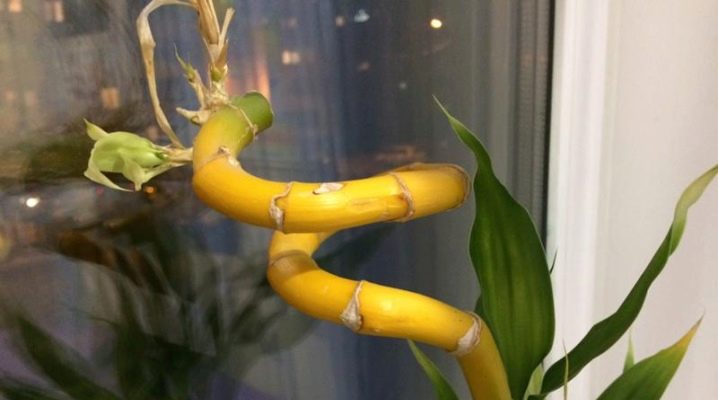
Many people who grow ornamental bamboo at home complain about a problem such as yellowing of the leaves and stem of this plant. This phenomenon can be caused by a variety of reasons - for example, improper growing conditions, pests or diseases. We will tell you about what to do with yellowed bamboo and how to treat it in our article.
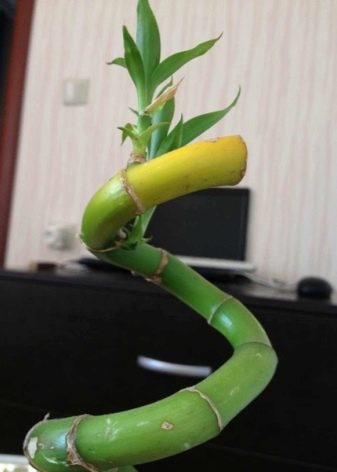
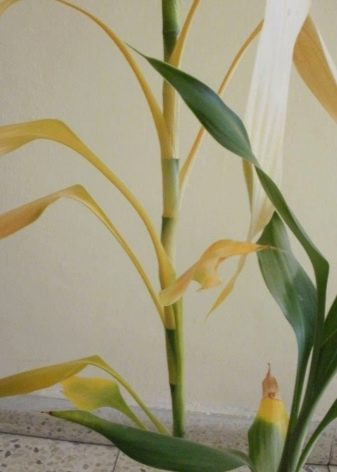
Improper care and poor conditions
If home-grown bamboo turns yellow, then, with a high probability, the reason for what is happening lies in the wrong conditions, which are uncomfortable for the plant.
- So, one of the reasons is the insufficient amount of applied fertilizers. Bamboo may simply lack the nutrients that are needed for the growth, development of the plant, strengthening its immunity and maintaining the green mass. For example, if a bamboo lacks nitrogen, then its trunk and leaves turn yellow, starting from the very tips. A similar phenomenon can also be observed with a shortage of copper and potassium in the earth. To deal with the problem, it is enough just to adjust the feeding mode. However, we note that you should not be zealous with it, because an excess of nutrients is also harmful to the plant: for example, if you apply too much dressing with a high content of manganese, then the bamboo stem will also begin to turn yellow.
- It is possible that the reason for the yellowing of bamboo lies in the water, namely in its quality. When growing indoor bamboo, it is important that the water you bring in is at room temperature and soft, with no excess in the form of calcium or chlorine. To do this, it must be filtered, boiled or defended.
- Lack of moisture also has a detrimental effect on bamboo, causing problems not only with the leaves, but also with the roots: they begin to die.... Typically, bamboo needs to be watered every five days during the summer. But in wet and cool weather, watering can be done at weekly intervals.
- Excessive light is also harmful to home bamboo, although in nature this plant grows very actively and without problems under the influence of sunlight.... Indoor bamboo does not tolerate sunlight well, because it inhibits its growth and development, causing the leaves to turn yellow on top and subsequently die off.
- Bamboo can also turn yellow due to insufficient space in the pot, because this plant has a powerful root system... If there is not enough space for it, then the plant will begin to slow down in growth, turn yellow and wither. Ideally, young plants are recommended to be replanted at least once a year, and adults - once every few years.
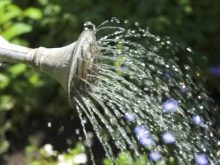

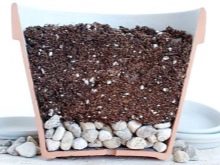
Note that when growing bamboo at home in a pot, drainage should be laid in the form of a layer of expanded clay. Without it, the remaining moisture will sour, which is why green mold subsequently forms, which will provoke the yellowness of the plant.
Diseases and their treatment
Diseases precipitate all cultivated plants, they do not bypass home bamboo, which is often the reason for the yellowing of the leaves and stems. As a rule, bamboo most often suffers from putrefactive diseases of fungal origin. It is quite easy to identify them: such pathologies cause wilting of plant leaves. They begin to become more faded, losing their color, then turn yellow, and then die off and begin to fall off.
Most often, this phenomenon is caused by too zealous watering of the plant, in particular, in cool weather, and the lack of adequate drainage. Of course, water is important for the development and growth of a plant, but its excess is very harmful.
It is not difficult to save the plant when this problem occurs. First you need to stop adding water, and also transplant bamboo into dry soil. In this case, the pot for growing the plant needs to be updated, because harmful fungi may well remain in the old pot, which are activated even in dry soil and will cause a lot of harm to the plant.
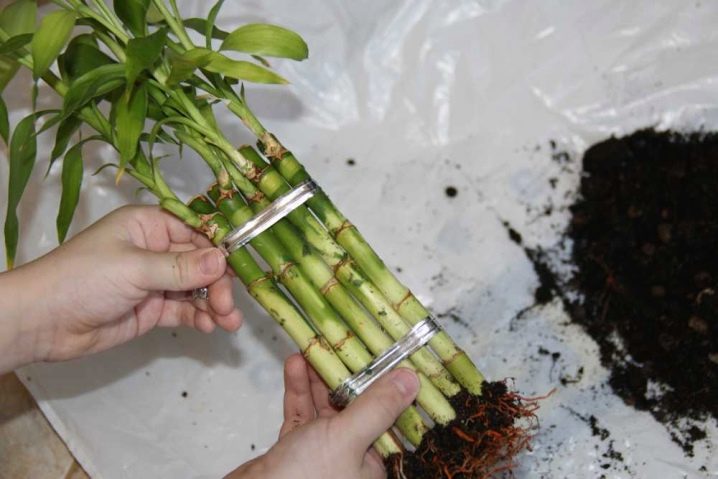
In addition, in order to provide the bamboo with more complete protection, it must be treated with special preparations against fungus, which can be purchased at a specialized store. One of the most effective remedies for bamboo fungus can be considered "Fundazol". Use it by dissolving one gram of the product in a liter of water.
Do not forget to also remove the decayed part of the root system before replanting. You should not regret, otherwise all your actions will be meaningless, and the bamboo will die as a result.
Additional disinfection of the plant root, which can be carried out by using a solution based on potassium permanganate or a good fungicidal agent, will be a big plus.

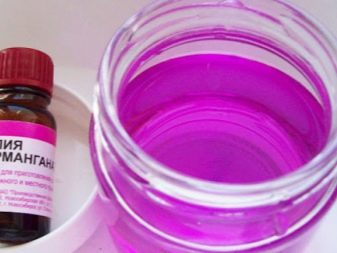
Pests and the fight against them
Thrips
Thrips can be considered the most dangerous pests of home bamboo. This is a very small insect, which, despite its tiny size, does great harm. As a rule, thrips settle in the area of bamboo leaves and twigs.
This parasite has an elongated body, the size of which usually does not exceed 1.5 mm. It has two pairs of wings and can fly, and also reproduces very actively. Females of these insects can be distinguished by their larger size and wider body.
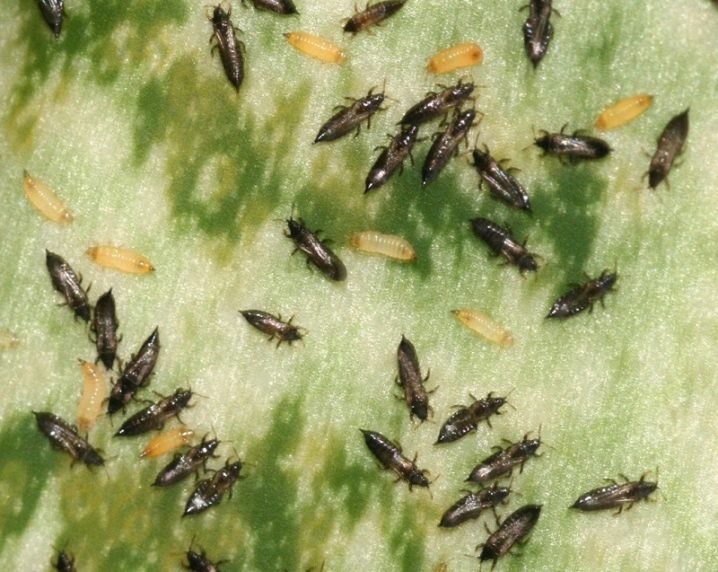
Both adults and larvae actively feed on the plant cell sap, which they receive from plant tissues. This inflicts huge damage on the bamboo, it begins to weaken and lose its immunity. As a result, those parts of the plant that have been damaged by parasites begin to die off and turn yellow, and small holes can be easily seen in them. At the same time, the leaves of the plant wither and fall off, which noticeably affects the appearance of the house plant: it loses its decorative effect.
If you do not intervene in time, then parasitic insects begin to gnaw bamboo buds, which is fraught with damage to almost all plant tissues. It is recommended to fight thrips as soon as you notice the first signs of their appearance. To do this, it is worth using insecticides.
Among the most effective means of this kind are Fitoverm, Aktellik and Vertimek.
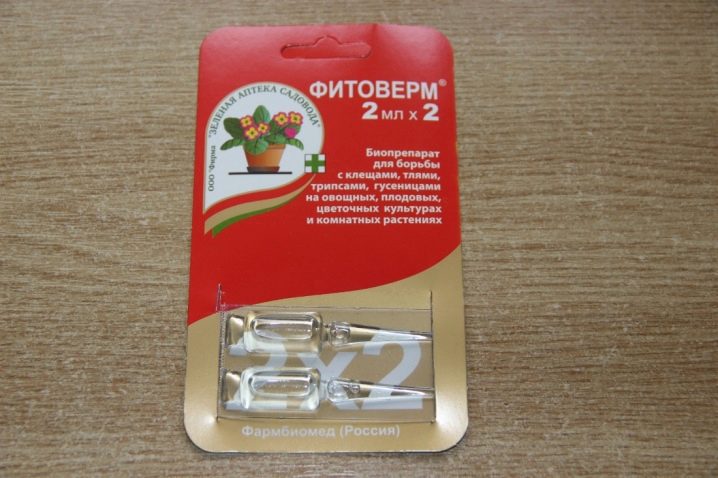
Aphid
Such a harmful insect as aphids is no less dangerous than the same thrips, because it has strong immunity and good resistance to all kinds of insecticides. For this reason, the fight against this parasite is quite difficult.
This insect is quite small in size, and its colors can be different - and white, and green, and black. As a rule, this pest settles on the back of the leaf, which is why it is extremely difficult to notice it immediately. Having settled on a plant, the aphid begins to feed on its juices, causing enormous damage to the culture, and at the same time secretes a special sticky substance. This substance is also harmful, because it can provoke the occurrence of diseases of fungal origin.
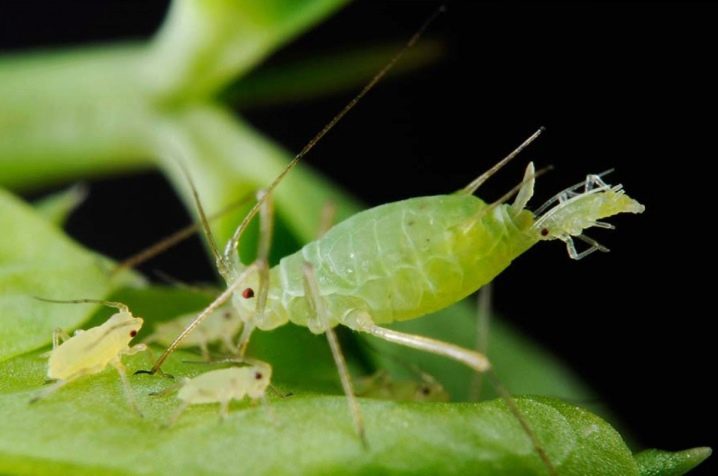
As a result, the plant, if the parasite is not eliminated in time, begins to wither, turn yellow, and then simply dies. To avoid this, it is necessary to fight against aphids at the first signs of its appearance. Chemicals such as Karbofos and Kinmix are perfect for this. In addition, you can resort to using folk recipes. So, to combat aphids, solutions based on onions, garlic, ash or tar soap are perfect.
Separately, we note that in the fall this parasite, as a rule, carries out egg-laying, which is why a new generation of pests appears by the spring.
Therefore, after processing using special tools, be sure to inspect the bamboo for nests with eggs.

Prophylaxis
Compliance with preventive measures allows you to deal with plant problems in time, if any, or prevent them altogether.
- For starters, we recommend that you regularly inspect bamboo for symptoms of disease or pest attacks. If you notice such, take concrete action immediately. At the same time, we recommend eliminating the yellowed areas of the plant in a timely manner so that they do not grow. You can remove sore areas with a pruner.
- Provide quality care for your home bamboo, because not only immunity, but also the appearance of the plant largely depends on it. Do not forget about high-quality and timely watering, making the required amount of dressings and changing the place for growing.
- In the summertime, do not forget to spray the plant with a spray bottlewhile wiping its leaves with a cloth soaked in water.
- In addition, it is worth providing home bamboo and quality lighting. He does not tolerate direct sunlight, but diffused light, on the contrary, will contribute to his growth and development.
We also recommend providing the plant with access to fresh air, but drafts should not be allowed: they are destructive for it.
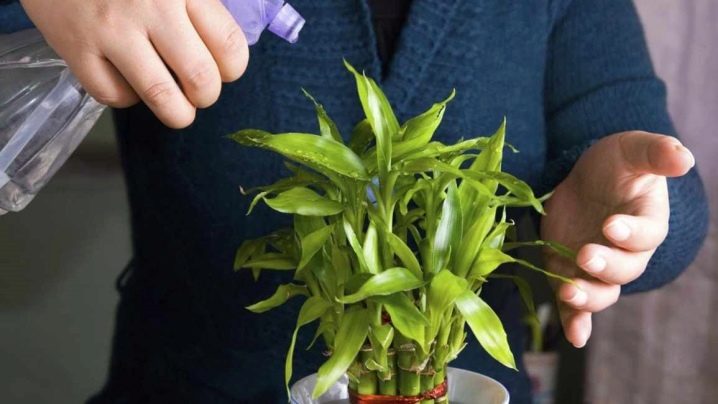



























The comment was sent successfully.